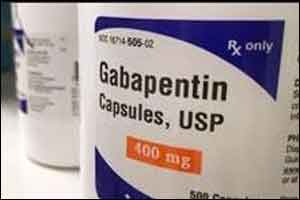- Home
- Editorial
- News
- Practice Guidelines
- Anesthesiology Guidelines
- Cancer Guidelines
- Cardiac Sciences Guidelines
- Critical Care Guidelines
- Dentistry Guidelines
- Dermatology Guidelines
- Diabetes and Endo Guidelines
- Diagnostics Guidelines
- ENT Guidelines
- Featured Practice Guidelines
- Gastroenterology Guidelines
- Geriatrics Guidelines
- Medicine Guidelines
- Nephrology Guidelines
- Neurosciences Guidelines
- Obs and Gynae Guidelines
- Ophthalmology Guidelines
- Orthopaedics Guidelines
- Paediatrics Guidelines
- Psychiatry Guidelines
- Pulmonology Guidelines
- Radiology Guidelines
- Surgery Guidelines
- Urology Guidelines
Gabapentinoid Use increases suicide risk particularly in young people: BMJ

Use of Gabapentinoids increases the risk of suicidal behaviour particularly in young people, finds a new study thereby necessitating a review of present treatment guidelines.
Gabapentinoids is a group of drugs used for epilepsy, nerve pain and anxiety disorders. Its use has been found to be associated with an increased risk of suicidal behaviour, unintentional overdose, injuries, and road traffic incidents. The new study from Sweden has been published by The BMJ today.
Gabapentinoids (gabapentin and pregabalin) were originally introduced as antiepileptics but have analgesic, anticonvulsant, and anxiolytic effects also. These easily tolerable drugs by patients have limited side-effects. Gabapentin an anti-epileptic drug binds to the alpha-2 delta subunit of the presynaptic voltage gated-calcium channels and inhibits calcium release so prevents the release of excitatory neurotransmitters involved in the pain pathways. Gabapentin has demonstrated analgesic effect in diabetic neuropathy, post-herpetic neuralgia, and neuropathic pain.
Their prescriptions have risen steeply in recent years, and gabapentinoids are among the top 15 drugs globally in terms of revenue. The risks of their use are strongest among 15 to 24 year-olds, prompting the researchers to suggest that treatment guidelines for young people should be reviewed.
Previous studies have linked gabapentinoids to suicidal behaviour and overdose related deaths, but findings have been inconsistent and data on longer-term harms are lacking.
Concerns that these drugs are also being used as an opioid substitute and for recreational use have led to prescribing restrictions in several countries, including the UK.
To help fill this evidence gap, an international research team examined associations between gabapentinoids and a range of harms including suicidal behaviour, unintentional overdose, injuries, road traffic incidents, and violent crime.
Using national prescription, patient, death, and crime registers, they identified 191,973 people aged 15 years and older who were prescribed pregabalin or gabapentin in Sweden between 2006 and 2013.
Overall, 59% of participants were women, and most were 45 years or older.
The researchers then compared the risk of harms during treatment periods with baseline risk during periods without treatment.
After taking account of potentially influential factors, they found that during treatment periods, participants were at a 26% increased risk of suicidal behaviour or death from suicide, a 24% increased risk of unintentional overdose, a 22% increased risk of head or body injuries, and a 13% increased risk of road traffic incidents or offences.
There were no statistically significant associations between gabapentinoid treatment and violent crime.
When drugs were examined separately, only pregabalin, not gabapentin, was associated with increased risks of harm.
And when the results were analysed by age, risks were greatest among 15 to 24 year-olds. This could be due to impulsivity and risk taking behaviour, or use of alcohol and illicit drugs alongside gabapentinoids, suggest the authors.
This is an observational study, so can’t establish cause, and the researchers weren’t able to account for drug adherence or any interplay between alcohol and illicit drug use. Nevertheless, this was a large study examining a wide range of outcomes and designed to minimise the effects of unmeasured (confounding) factors.
Further research is needed to better understand the increased risks found in adolescents and young adults prescribed gabapentinoids, particularly for suicidal behaviour and unintentional overdoses, while clinical guidelines may also need review, they conclude.
In a linked editorial, Derek Tracy, a consultant psychiatrist at Queen Mary’s Hospital in London, says these findings provide “solid data to inform patients on the risks associated with treatment.”
The findings suggest it might be time to uncouple pregabalin and gabapentin for the purposes of legislation and guidelines, he writes. “We also need to understand what is driving the age related differences in risks and how recent legal restrictions will affect the illicit market in diverted drugs.”
Despite reasonable concerns, gabapentinoids “remain a valued therapeutic option for many people,” he concludes. “Medicines can harm as well as heal, and the best treatment decisions are made in full partnership with patients, after consideration of all available evidence on both.”
For more details click on the link: http://www.bmj.com/content/

Disclaimer: This site is primarily intended for healthcare professionals. Any content/information on this website does not replace the advice of medical and/or health professionals and should not be construed as medical/diagnostic advice/endorsement or prescription. Use of this site is subject to our terms of use, privacy policy, advertisement policy. © 2020 Minerva Medical Treatment Pvt Ltd